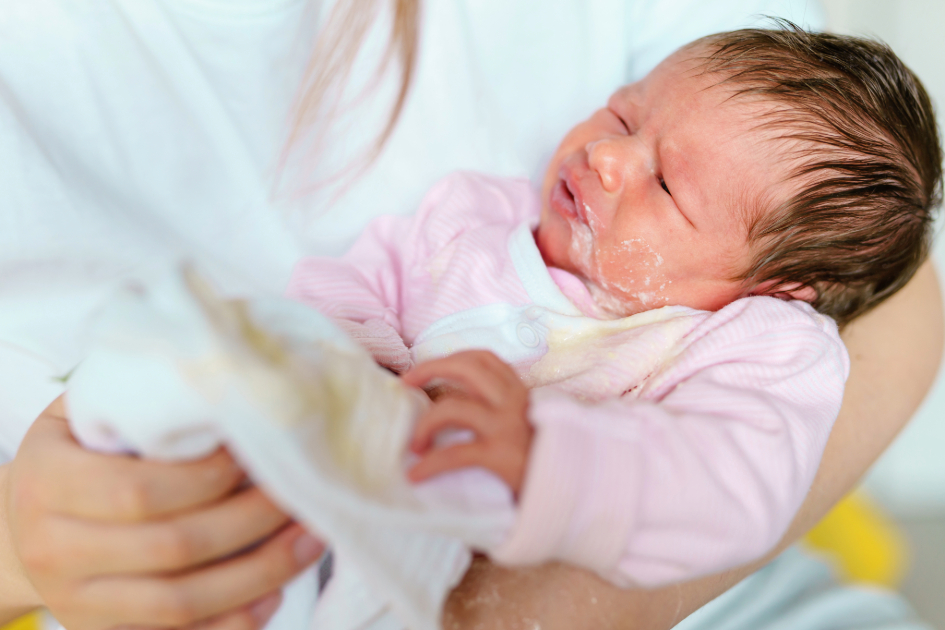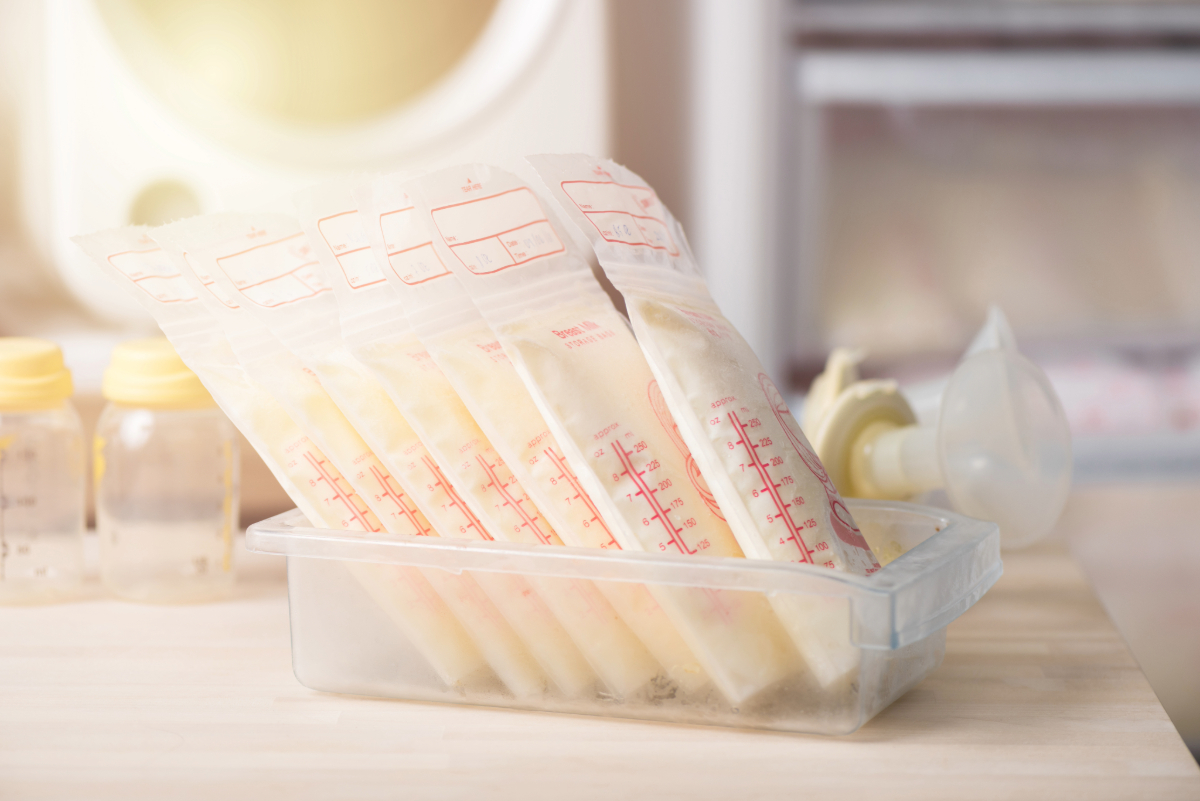Breastfeeding is a natural and beneficial practice for both mother and baby. However, it can sometimes come with concerns, such as when your baby vomits or possets after feeding. While this can be distressing, it’s important to understand the possible causes and implications. Vomiting and posseting are common occurrences in infants and are often not a cause for alarm.
This guide will help you differentiate between normal posseting and more concerning vomiting episodes, guiding you to ensure your baby’s health and comfort during breastfeeding.
The 3 Stages Of Breast Milk
Understanding the different stages of breast milk can help you better support your baby’s nutritional needs. Each stage offers unique benefits tailored to your newborn’s development. Here are the three critical stages of breast milk production:
- Colostrum: A thick, yellowish fluid produced during pregnancy and just after birth. It is rich in antibodies and nutrients, providing essential immunity and nutrition to the newborn.
- Transitional Milk: Appears after colostrum and lasts for about two weeks. It has higher levels of fat, lactose, and calories to support the baby’s growing needs.
- Mature Milk: Develops about two weeks postpartum and is composed of foremilk and hindmilk, ensuring the infant receives both hydration and essential nutrients for sustained growth.
Is It Normal For A Baby To Vomit While Breastfeeding?
It is common for babies to regurgitate small amounts of milk occasionally during or after nursing. This is known as possetting and is typically not a cause for concern. However, if your baby is frequently vomiting or showing signs of discomfort, it could indicate a problem. Causes might include an allergy to a substance in the mother’s milk, overfeeding, or a medical condition such as gastroesophageal reflux. If vomiting persists, it’s crucial to consult with your child’s healthcare provider for a proper evaluation.

How To Avoid Baby Vomiting After Breastfeeding?
- Ensure your baby is not overfed: Regularly monitor the quantity of breast milk your baby consumes to prevent overfeeding, which can lead to vomiting.
- Try a slower paced feeding: Allow your baby to take breaks and burp during breastfeeding sessions. This can help reduce the accumulation of gas, which could induce vomiting.
- Position your baby correctly: Use a semi-upright position during feeding and keep your baby upright for at least 20-30 minutes after feeding to aid digestion and prevent vomiting.
- Avoid disruptions during feed: Minimize distractions during breastfeeding since a quiet and peaceful environment can help your baby eat more slowly and digest better.
- Seek professional advice if you have had breast surgery: Certain surgeries may impact breastfeeding, and professional advice can provide tailored strategies for successful breastfeeding without causing harm to the baby.
What’s The Difference Between Spitting Up and Vomiting?
Spitting up is a common occurrence among infants, characterized by the regurgitation of small amounts of milk after feeding. This phenomenon is usually benign, occurring because the infant’s digestive system is still developing. On the other hand, vomiting refers to the more forceful expulsion of larger amounts of stomach content. It can be caused by a variety of factors, ranging from illness and infection to overfeeding.
How Can I Keep My Baby From Spitting Up?
- Avoid overfeeding by observing your baby’s feeding cues, as babies usually know when they’ve had enough.
- Ensure a good latch during feeding sessions.
- Try to maintain a calm and unrushed atmosphere while feeding your baby.
- Hold your baby upright for about 15 to 30 minutes after breastfeeding to aid in digestion.
- Refrain from engaging your baby in active play immediately after a feed to minimize the chances of spitting up.
Over Breastfeeding Explained
How much breast milk should an infant consume per day?
The amount of breast milk an infant should consume varies with age. Newborns usually consume approximately 1.5 to 3 ounces every 2 to 3 hours. This will gradually increase to 4 to 5 ounces as your baby grows. However, these are guiding figures and the amounts can slightly vary depending on your baby’s needs.
What symptoms indicate a child is suffering from over breastfeeding?
Signs that a child might be overfed include frequent spit-ups, gas, and discomfort during and after feeding. Apart from physical symptoms, behavioral indicators such as restlessness, difficulty sleeping, and frequent feeding may also suggest over-breastfeeding. Consistent weight gain significantly above the recommended range may further indicate overfeeding.
Drawbacks associated with over breastfeeding
Over-breastfeeding can contribute to the onset of unhealthy weight gain in the child, potentially leading to obesity early in life. It might also encourage unhealthy feeding patterns, possibly resulting in problems with self-regulation of food intake as the child grows. In addition, overfeeding can cause discomfort and digestive issues like diarrhea or constipation.
How to prevent over breastfeeding
To prevent over-breastfeeding, mothers should focus on recognizing their baby’s hunger and fullness signals rather than rigid feeding schedules. Stopping the feed when the baby shows signs of satisfaction, such as slowing down, releasing the nipple, or turning away, will help to avoid overfeeding. Discussing the baby’s growth and feeding patterns with a healthcare professional can also provide valuable guidance.

What Can I Do If My Baby Bites During Breastfeeding?
If your baby bites during breastfeeding, it can be an upsetting and painful experience. However, there are steps you can take to alleviate this issue. First, observe your baby’s feeding pattern; biting often occurs at the end of nursing when the baby is no longer hungry but continues to suckle for comfort. Pulling away suddenly when bitten may cause your baby to bite down harder. Instead, try pushing your baby gently towards your breast, this may cause your baby to release the grip.
Also, if you notice your baby is likely to bite, detach them gently from your breast and transition them to a teething toy or a pacifier. Finally, do not forget to express any discomfort to the child calmly, explaining that biting hurts, to start instilling the principle of gentleness. With patience, persistence, and a gentle hand, biting during breastfeeding can be successfully resolved.
Does Freezing Breast Milk Affect Its Nutritional Value?
Freezing breast milk does not significantly decrease its nutritional value. While minor variations in vitamin and antioxidant content may occur, these changes are minimal and not detrimental to the baby’s health. The crucial elements, such as proteins and fats, maintain their nutritional integrity even after freezing. Therefore, it’s safe to say that freezing breast milk remains an effective way of storing and preserving milk while retaining the majority of its nutritional benefits.
Certain precautions should be taken while freezing breast milk. It should be frozen as soon as possible after expression, preferably within 24 hours. The temperature of the freezer also matters – the colder, the better. Package the milk in sterile containers, filling to allow some space for expansion during the freezing process. Always remember to label the containers with the date of expression.
When it’s time to use the frozen milk, thaw it in the refrigerator or under cool running water. Avoid using a microwave to thaw or heat breast milk as it can create hot spots that could potentially burn the baby.
Nearly 80% of mothers in the United States start breastfeeding immediately after birth
| Method | Instructions | Notes |
| Refrigerator | Place frozen milk in the refrigerator to thaw | Thawed milk should be used within 24 hours |
| Running Water | Place frozen milk under cool running water until thawed | Thawed milk should be used immediately |
| Microwave | Avoid using the microwave to heat breast milk | Can create hot spots, leading to potential burns |

What Is A Normal Healthy Breastfed Baby Poo?
The appearance of a breastfed baby’s stool may vary. In their first days of life, the stool is typically greenish-black and sticky, a substance known as meconium. As the baby continues to breastfeed, the stool transitions to a mustard-yellow color, with a loose, semi-liquid consistency. It’s common to notice small, seed-like particles as well. These changes in color and texture are normal and indicate that the baby is receiving adequate breast milk. However, should there be signs of blood, mucus, or a sudden change to a watery consistency, it’s crucial to seek medical advice promptly.
Forums
The provided list contains various online resources where mothers can seek advice, share experiences, and learn about breastfeeding. The list covers a broad spectrum of communities – from parent-centered forums to professional organizations dedicated to supporting breastfeeding mothers.
- BabyCenter – Breastfeeding Support and Help is an online community where mothers can connect and exchange advice about breastfeeding concerns and challenges.
- What to Expect – Breastfeeding Forum is a dedicated space for discussing various breastfeeding-related topics, from overcoming difficulties to sharing milestones and success stories.
- La Leche League – Forums is a recognized platform provided by an international organization promoting breastfeeding. Here, mothers can seek professional guidance and support.
- Mumsnet – Breast and Bottle Feeding gives mothers the opportunity to discuss both breastfeeding and bottle feeding, allowing a balanced view on feeding options.
- Reddit – Breastfeeding Subreddit gives insights into real-life stories from a diverse group of international mothers navigating their breastfeeding journey.
- NetMums – Breastfeeding is an online community with a relaxed, informal atmosphere where mothers can communicate openly about their experiences.
Find a Pediatrician Near You
Are you looking for exceptional healthcare for your child? East Lake Pediatrics, with offices conveniently located in Trinity, Oldsmar, and Palm Harbor. Our team of experienced pediatricians are dedicated to ensuring your child’s health and well-being through every stage of their development.
Why Choose East Lake Pediatrics?
- Personalized Care: We tailor our services to meet the unique needs of each child.
- Experienced Team: Our skilled pediatricians are experts in child health.
- Convenient Locations: Easily accessible offices in Trinity, Oldsmar, and Palm Harbor.
- Comprehensive Services: From routine check-ups to specialized care, we offer a full range of pediatric services.
Schedule Your Appointment Today! Visit our website at East Lake Pediatrics or call us at (727) 786-5488 to book an appointment. Ensure your child receives the best care available. Trust East Lake Pediatrics for a healthy and happy future!
Join Our Family at East Lake Pediatrics – Where Your Child’s Health is Our Priority!
Disclaimer: This article is for informational purposes only and does not replace professional medical advice. Always consult your doctor for medical concerns. Do not delay seeking medical help because of information provided here.

